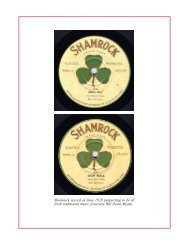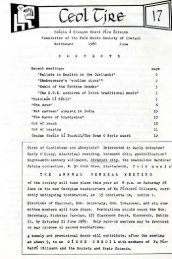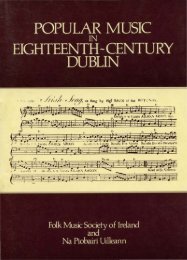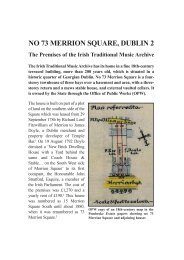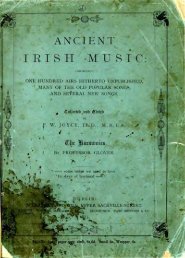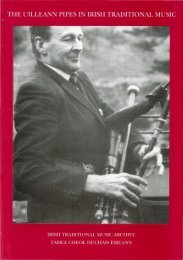Union Pipes - Irish Traditional Music Archive
Union Pipes - Irish Traditional Music Archive
Union Pipes - Irish Traditional Music Archive
You also want an ePaper? Increase the reach of your titles
YUMPU automatically turns print PDFs into web optimized ePapers that Google loves.
COURTNEY’S ‘UNION PIPES’ AND THE TERMINOLOGY OF IRISH BELLOWS-BLOWN BAGPIPES 4<br />
existence by the late seventeenth century, 6 and to have been subject<br />
to processes of development that continued through the eighteenth<br />
and into the nineteenth centuries. Distinct traditions of bellows-pipes<br />
manufacture and playing would survive in Scotland, northern<br />
England, and Ireland after bagpipes had fallen out of favour in most<br />
of Britain. No early insular makers are known, but the attachment of<br />
bellows to existing types of bagpipes, or the importation of a small<br />
number of Continental bellows pipes, probably of different kinds,<br />
would have been sufficient to set chain reactions in motion among<br />
innovative makers. Bellows pipes would always be peripheral<br />
instruments in these islands, and would never be played in any great<br />
numbers. They would never begin to rival the recorder, violin,<br />
German flute or keyboard instruments in popularity, and the major<br />
music publishers of Britain and Ireland would not publish music or<br />
tutors for them as they would for those instruments. But bellows<br />
pipes have often been accorded an elite status, specialist publishers<br />
have long produced tutors and tune books for them, and they have<br />
exerted a persistent, powerful and unique fascination on players and<br />
listeners here for over three centuries now. They currently enjoy an<br />
unprecedented worldwide level of popularity.<br />
6<br />
For Britain there is the evidence of the English playwright Thomas Shadwell<br />
who in his 1671 play The Humorists refers to ‘a Scotch-Bag-Pipe that has got a<br />
flaw in the Bellows’ (quoted in Stewart 2009: 53; from Keith Sanger) and that<br />
of the English organologist James Talbot who c. 1685–1700 listed ‘Scotch’<br />
bellows bagpipes which he had seen (Cocks 1952: 44–5). In both instances<br />
‘Scotch’ may mean ‘north British’. By the 1720s there is further evidence of<br />
various kinds of Scottish and northern English bellows pipes (Sanger 1989: 11–<br />
13). The <strong>Irish</strong> evidence is less explicit, not mentioning bellows until the 1750s,<br />
but there are references from the 1680s to bagpipes being played in domestic<br />
settings with harp and fiddle and these must have been pipes of the new kind<br />
(Carolan 2010: 6–7). Larry Neal M’Elvanna, an ‘<strong>Irish</strong> piper of note’ who died in<br />
Co Down in 1746 in his 78th year, was reported as having learned to play the<br />
pipes from Piper Malone of Lurgan, ‘who died in 1700 at the advanced age of<br />
100’ (Walker’s Courant, Sept. 1746, quoted in An Píobaire vol. 3, no 35, Apr.<br />
1998: 23). By 1746 a noted <strong>Irish</strong> piper was doubtless a bellows piper.



